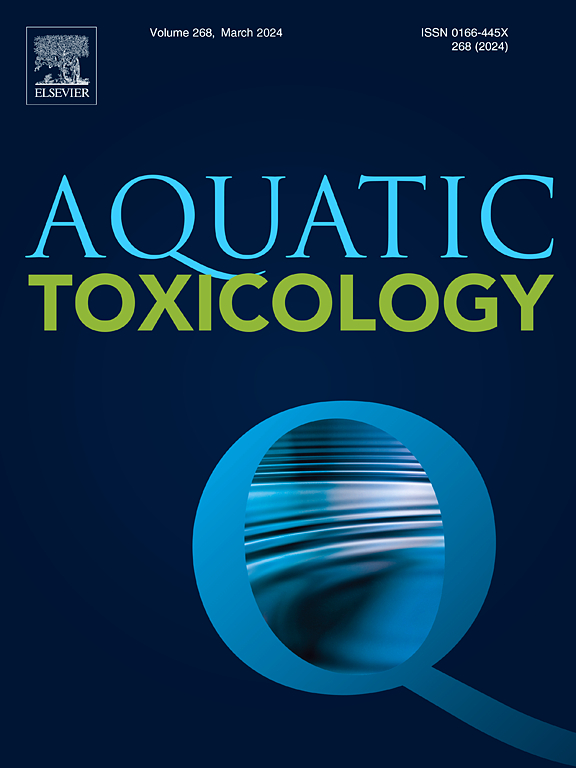Microplastic toxicity in aquatic organisms across phylogeny
IF 4.1
2区 环境科学与生态学
Q1 MARINE & FRESHWATER BIOLOGY
引用次数: 0
Abstract
Microplastic (MP) contamination of aquatic ecosystem had been escalated several folds and became concerning for the inhabiting organisms. Their accumulation in aquatic biota, ranging from lower invertebrates to higher vertebrates, underscores the severity of their toxicological impact and raises critical concerns for ecosystem health. Many of the researchers concentrated on assessment of MP distribution across environmental compartments and analysis of the physicochemical characteristics and their bioaccumulation in freshwater and marine species. Current review provides a comprehensive information on toxicological outcomes across various aquatic phyla exposed to MP polymers. This review collates evidence from diverse studies documenting MP-induced toxic responses, such as genotoxicity, reproductive toxicity, behavioural alterations and oxidative stress in different aquatic metazoans. Additionally, it highlights the role of MPs as vectors of xenobiotics and harmful pathogenic microorganisms, further amplifying their toxic potential on aquatic biota. Reports of physiological toxicity of MPs were reviewed phylogenetically including the extant invertebrates, protochordates and chordates. Our review is the first cross-phylum assessment of MP toxicity. We analysed pollutant vector effects on organisms including invertebrates and vertebrates. Cross species comparisons were made in relation to the perspectives of evolutionary toxicology. This review presents an indepth report of MP toxicity across phylogeny. Whereas, the previous reviews center around single phylum. This review would provide a rich and holistic information base of MP toxicity in the organisms of aquatic ecosystem.
跨系统发育水生生物的微塑性毒性
水生生态系统的微塑料污染已经上升了好几倍,引起了栖息生物的关注。它们在从低等无脊椎动物到高等脊椎动物的水生生物群中的积累,凸显了其毒理学影响的严重性,并引起了对生态系统健康的严重关切。许多研究人员集中在评估MP在环境隔间中的分布,分析其物理化学特征及其在淡水和海洋物种中的生物积累。目前的综述提供了暴露于多聚丙烯酸甲酯聚合物的各种水生门的毒理学结果的全面信息。本综述整理了来自不同研究的证据,这些研究记录了mp诱导的毒性反应,如遗传毒性、生殖毒性、行为改变和不同水生后生动物的氧化应激。此外,它还强调了MPs作为外源生物和有害致病微生物载体的作用,进一步放大了它们对水生生物群的毒性潜力。从系统发育的角度综述了MPs生理毒性的报道,包括现存的无脊椎动物、原脊索动物和脊索动物。我们的综述是首个跨门的MP毒性评估。我们分析了污染物载体对生物的影响,包括无脊椎动物和脊椎动物。从进化毒理学的角度进行了跨物种比较。本文综述了跨系统发育的MP毒性的深入报道。而以往的研究主要围绕单门展开。本综述将为水生生态系统生物中多聚磷毒性研究提供一个丰富而全面的信息基础。
本文章由计算机程序翻译,如有差异,请以英文原文为准。
求助全文
约1分钟内获得全文
求助全文
来源期刊

Aquatic Toxicology
环境科学-毒理学
CiteScore
7.10
自引率
4.40%
发文量
250
审稿时长
56 days
期刊介绍:
Aquatic Toxicology publishes significant contributions that increase the understanding of the impact of harmful substances (including natural and synthetic chemicals) on aquatic organisms and ecosystems.
Aquatic Toxicology considers both laboratory and field studies with a focus on marine/ freshwater environments. We strive to attract high quality original scientific papers, critical reviews and expert opinion papers in the following areas: Effects of harmful substances on molecular, cellular, sub-organismal, organismal, population, community, and ecosystem level; Toxic Mechanisms; Genetic disturbances, transgenerational effects, behavioral and adaptive responses; Impacts of harmful substances on structure, function of and services provided by aquatic ecosystems; Mixture toxicity assessment; Statistical approaches to predict exposure to and hazards of contaminants
The journal also considers manuscripts in other areas, such as the development of innovative concepts, approaches, and methodologies, which promote the wider application of toxicological datasets to the protection of aquatic environments and inform ecological risk assessments and decision making by relevant authorities.
 求助内容:
求助内容: 应助结果提醒方式:
应助结果提醒方式:


